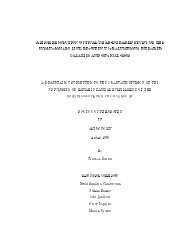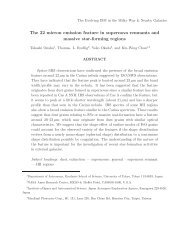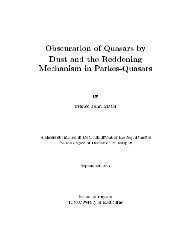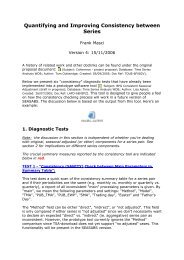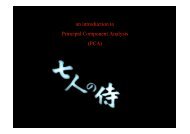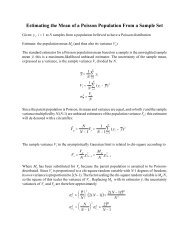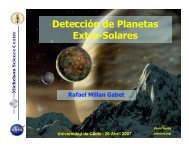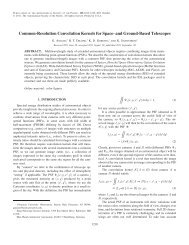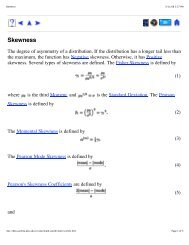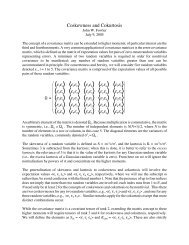PDF Version - Caltech
PDF Version - Caltech
PDF Version - Caltech
Create successful ePaper yourself
Turn your PDF publications into a flip-book with our unique Google optimized e-Paper software.
DAVID R . ARDILA<br />
Spitzer Science Center<br />
California Institute Of Technology<br />
MS 220-6, Pasadena, CA 91125, U.S.A.<br />
Tel: 626 395 1945, Fax: 626 583 9046<br />
Email: ardila@ipac.caltech.edu<br />
EDUCATION<br />
• Ph.D., Physics (Astrophysics), University of California, Berkeley, CA, Sept. 2002<br />
o Thesis: Magnetospheric Accretion in Young Stars (under the direction of Gibor<br />
Basri)<br />
• M.Sc., Physics (Nuclear Physics), Purdue University, West Lafayette, IN, 1995<br />
• B.Sc., Physics (Condensed Matter), University of Los Andes, Bogotá, Colombia, S.A.,<br />
1993<br />
o Thesis: Low-Dimensionality electronic systems (under the direction of Luis<br />
Quiroga)<br />
SUMMARY OF RESEARCH INTERESTS<br />
Planet Formation: Observations and modeling of debris disks, timescales of planet formation.<br />
Coronagraphic observations of circumstellar disks. Hydrodynamical simulations of dust-gas<br />
interactions.<br />
Star Formation: Observations and modeling of the accretion process in T Tauri and Herbig<br />
Ae/Be stars. Angular momentum evolution. Extension of the accretion paradigm to lower stellar<br />
masses. Line emission in high temperature plasmas.<br />
CURRENT POSITION<br />
Spitzer Science Center, Assistant Research Scientist: 50% functional - 50% research. Task<br />
Lead for the Spitzer Spectroscopic Heritage Atlas.<br />
RESEARCH EXPERIENCE<br />
May 2005 - Present: Spitzer Science Center (SSC), <strong>Caltech</strong>, Pasadena, CA<br />
• Coronagraphic Observations of Debris Disks: to expand the sample of resolved debris<br />
disks in scattered light.<br />
• Gas evolution in protoplanetary disks: to understand the transition from optically thick to<br />
optically thin protoplanetary disks.<br />
• High temperature plasmas in young stars: to understand accretion columns in Classical T<br />
Tauri Stars.<br />
• Debris disks around stars with planets: to study the relationship between debris disks and<br />
stars with planets.<br />
August 2002 – May 2005: Advanced Camera for Surveys, Johns Hopkins University,<br />
Baltimore, MD<br />
David R. Ardila, CV Nov. 2007 1
Associate Research Scientist with the Guaranteed Time of Observation (GTO) Science Team<br />
of the Advanced Camera for Surveys (ACS). As part of the circumstellar disk group,<br />
designed, reduced, and analized observations of circumstellar disks around main-sequence<br />
stars. Performed dynamical and radiative modeling of optically thin scattered-light optical<br />
images of disks.<br />
August 1997 – September 2002: University of California, Astronomy Department,<br />
Berkeley, CA<br />
As a graduate student performed research in a variety of fields.<br />
• In star formation, studied the interaction between the disk and the central star in<br />
Classical T-Tauri Stars, using high resolution optical (the Hamilton echelle spectrograph<br />
on Lick Observatory and HIRES on Keck) and UV (GHRS and STIS on HST)<br />
spectroscopy. Also, studied the origin of brown dwarfs, by searching for circumstellar<br />
disks around these objects, using mid-IR photometry (primarily ISAAC at VLT and<br />
NIRC at Keck).<br />
• In the search and characterization of low-mass stars and brown dwarfs, lead survey<br />
searches for these objects in young clusters, using wide field cameras (the Michigan<br />
Curtis-Schmidt at CTIO, and the Prime Focus Camera at Lick Observatory) and lowresolution<br />
spectroscopy (LRIS at Keck, and the Kast Spectrograph at Lick).<br />
• Other studies included the characterization of chromospheric activity in low-mass stars<br />
(using low-resolution spectroscopy) and nature of the X-ray emission in Classical T<br />
Tauri Stars (using Chandra).<br />
August 1993 - December 1994: Purdue University, Physics Department, West Lafayette,<br />
IN<br />
As part of the Nuclear Physics group, and under the direction of Andrew Hirsch, explored the<br />
dielectric characteristics of Helium-Argon mixtures to be used as media for the Solenoidal<br />
Tracker at RHIC (STAR), a detector currently in use in the Relativistic Heavy Ion Collider at<br />
Brookhaven National Laboratory.<br />
1992: University of Los Andes, Physics Department, Bogotá, Colombia.<br />
As part of the condensed matter group, performed theoretical investigations in the quantum<br />
Hall effect, as occurs in 2-D electronic systems.<br />
INSTRUMENT EXPERIENCE<br />
May 2005 – Present : Spitzer Science Center, Pasadena, CA<br />
Functional work at SSC divided among the Infrared Spectrograph Group (IRS) and Observer<br />
Support. In addition, lead the effort for the Spitzer Spectroscopic Heritage Atlas.<br />
For the IRS, duties include:<br />
• Periodic spectrophotometric calibration of the spectrograph and peak-up arrays.<br />
• Design of observations campaigns to obtain standard star observations<br />
• General monitoring of the precision and accuracy reachable with the IRS<br />
• Managing and updating webpages relating the spectrogrph (calibration information,<br />
known artifacts, etc)<br />
For Observer Support, the duties include:<br />
David R. Ardila, CV Nov. 2007 2
• Performing technical reviews of accepted proposals<br />
• Updating of the IRS manual and Data Handbook<br />
• Monitoring bright object limits<br />
• Answering community questions on the spectrograph<br />
As lead of the Spitzer Spectroscopic Heritage Atlas:<br />
• Select targets for the Atlas, design AORs for observations.<br />
• Interact with team members regarding scientific priorities for the Atlas content.<br />
• Reduce current archive data, design final archive.<br />
As an SSC member:<br />
• Participate and contribute to talks regarding final form of the Spitzer Data Archive.<br />
June 1999 – August 2002: Space Sciences Laboratory, Berkeley, CA<br />
Responsibilities included writing software for the Reuven Ramati High Energy Solar<br />
Spectroscopic Imager satellite (RHESSI), launched in 2002. The software produced simulated<br />
data for the purposes of testing all the aspects of the spacecraft's data collection systems,<br />
extracted telemetry information from the spacecraft data streams, and processed and analyzed<br />
the scientific data from the satellite. Responsible for designing robust, reliable, and clear<br />
software used by the satellite's end user.<br />
1995: Lawrence Berkeley National Laboratory, Berkeley, CA<br />
As part of the STAR development team, designed and developed testing procedures for<br />
detector parts. Wrote software to control machinery that measured different characteristics of<br />
the device (such as electrical and physical integrity, mechanical soundness).<br />
SERVICE<br />
On-going: Astrophysical Journal, Astronomical Journal<br />
Referee<br />
2008: Space Telescope Science Institute<br />
Hubble Space Telescope, Time Allocation Committee, panel member.<br />
2006: Spitzer Science Center<br />
Science advisor for students under Spitzer’s Visiting Graduate Student Program.<br />
2006: Infrared Processing and Analysis Center (IPAC)<br />
Cool Stars XIV, Local Organizing Committee member<br />
2005: Spitzer Science Center<br />
Spitzer Graduate Fellowship, panel member<br />
2003 – 2004: Johns Hopkins University<br />
Mentored students within the Space Telescope Science Institute Summer Student Program<br />
2001 – 2002: Astronomical Society of the Pacific, San Francisco, CA<br />
Translated and copy-edited translations (from english to spanish) of Project Astro and Family<br />
David R. Ardila, CV Nov. 2007 3
Astro materials (www.astrosociety.org/education/astro/project_astro.html).<br />
2000 – 2002: University of California, Astronomy Department, Berkeley, CA<br />
In charge of the public hotline for the Department. Answered questions from the public in a<br />
variety of topics (UFOs, Cosmology, the end of Ramadan, etc). Provided expert support for<br />
theater plays and legal depositions.<br />
TEACHING EXPERIENCE<br />
2000: Astronomical Society of the Pacific, San Francisco, CA<br />
As a volunter astronomer, participated in Project Astro for the West Oakland elementary<br />
Schools.<br />
1995 – 1997: University of California, Astronomy Department, Berkeley, CA<br />
Teaching Assistant for general Physics and Astronomy classes.<br />
1993 – 1994: Purdue University, Physics Department, West Lafayette, IN<br />
Teaching Assistant for general Physics classes.<br />
1990 – 1992: University of Los Andes, Physics Department, Bogotá, Colombia.<br />
Teaching Assistant for general Physics classes.<br />
SOME RECENT TALKS<br />
August 2007: “A Search for Debris Disks in the Beta Pictoris moving group”, ACS-GTO<br />
retreat, Jackson Hole, WY<br />
May 2007: “Evidence for Magnetospheric Accretion in Young Stars”, IAU Symposium 243:<br />
Grenoble.<br />
November 2006: “Evidence for Disk Evolution in HD 100546”, Cool Stars XIV: Pasadena<br />
September 2006: “Current Status of the ACS Coronagraphic Program”, ACS-GTO Retreat,<br />
Jackson Hole<br />
August 2006: “Star and Planet Formation”, Workshop of five talks to advanced<br />
undergraduates, University of Los Andes, Bogotá, Colombia<br />
AWARDS, GRANTS, PROFESSIONAL SOCIETIES<br />
American Astronomical Society Member<br />
American Association for the Advancement of Science Member<br />
Awarded HST/ACS Observing Time proposal # 10828 (P.I. Liu)<br />
Awarded HST/ACS Observing Time proposal # 10487 (P.I. Ardila)<br />
David R. Ardila, CV Nov. 2007 4
Awarded HST/ACS Observing Time proposal # 10539 (P.I. Stapelfelt)<br />
Awarded HST/ACS Guaranteed Observing Time proposals # 8992, 9295, 9703, 9987,<br />
10330, 10695, (P.I. Ford)<br />
Awarded HST/STIS Observing Time proposal # 10221 (P.I. Herczeg)<br />
Awarded funding for HST Theory proposal # 9933 (P.I. Johns-Krull)<br />
Awarded funding for CXO Archival proposal # 0529 (P.I. Barsony)<br />
National Research Council Fellowship – 2005 (Declined)<br />
Mention for outstanding contribution to the RHESSI project – 2002<br />
Graduate Opportunity Fellowship, UC Berkeley - 1995<br />
Undergraduate Excellence Fellowship – 1990 to 1992: University of Los Andes, Bogota,<br />
Colombia<br />
Andres Bello Medal – 1987: From the Colombian Government to the 100 best high school<br />
students in the country, as defined by the state-administered tests.<br />
RELEVANT PROFESSIONAL REFERENCES<br />
Holland Ford (ACS PI, ford@pha.jhu.edu)<br />
Steve Lubow (STScI, lubow@stsci.edu)<br />
Keivan Stassun (Vanderbilt University, keivan.stassun@vanderbilt.edu)<br />
David Golimowski (Johns Hopkins University, dag@pha.jhu.edu)<br />
John Krist (Jet Propulsion Laboratory, john.e.krist@jpl.nasa.gov)<br />
Gibor Basri (Ph.D. Advisor, Berkeley, basri@soleil.berkeley.edu)<br />
Christopher Johns-Krull (Rice University, cmj@rice.edu)<br />
Mark Clampin (GSFC, mark.clampin@nasa.gov)<br />
SSC FUNCTIONAL REFERENCES<br />
John Stauffer (Scientist Manager SSC, stauffer@ipac.caltech.edu)<br />
Lee Armus (Supervisor SSC, lee@ipac.caltech.edu)<br />
Schuyler Van Dyk (Supervisor SSC, vandyk@ipac.caltech.edu)<br />
David R. Ardila, CV Nov. 2007 5
List of Publications for David R. Ardila<br />
When Ardila is fourth author or later, the author list has been truncated to “et al.”<br />
Refereed Publications:<br />
1. Kóspál, Á. & Ardila, D.R., 2008, On the Relationship between Debris Disks and<br />
Planets, 2008, ApJL, submitted<br />
2. Kóspál, Á., Ábrahám, P., Apai, D., Ardila, D.R. et al. High-resolution polarimetry of<br />
Parsamian 21: revealing the structure of an edge-on FU Ori disc, 2007, MNRAS, in<br />
press<br />
3. Hebb, L., Petro, L., Ford, H., Ardila, D. R. et al. Search for Planetary Transits of the<br />
Debris Disk Star AU Mic, 2007, MNRAS, 379, 63<br />
4. Ardila, D.R. et al. ACS/HRC Coronagraphic Observations of the Disk around HD<br />
100546, 2007, Astrophysical Journal, 665, 512<br />
5. Doering, R. L. et al. HD 97048's Circumstellar Environment as Revealed by a<br />
Hubble Space Telescope ACS Coronagraphic Study of Disk Candidate Stars, 2007,<br />
AJ, 133, 2122<br />
6. Schneider, G., et al. Discovery of an 86 AU Radius Debris Ring around HD 181327,<br />
2006, Astrophysical Journal, 650, 414<br />
7. Golimowski D. A., Ardila D. R., Krist J. E., Clampin M. et al. Hubble Space Telescope<br />
ACS Multiband Coronagraphic Imaging of the Debris Disk around β Pictoris, 2006,<br />
Astronomical Journal, 131, 3109<br />
8. Krist, J. E., et al. Hubble Space Telescope ACS Images of the GG Tauri<br />
Circumbinary Disk, 2005, Astronomical Journal, 130, 2778<br />
9. Ardila, D. R. et al. A Dynamical Simulation of the Debris Disk around HD 141569A,<br />
2005, Astrophysical Journal, 627, 986<br />
10. Herczeg, G. J., et al. The Loopy Ultraviolet Line Profiles of RU Lupi: Accretion,<br />
Outflows, and Fluorescence, 2005, Astronomical Journal, 129, 2777<br />
11. Krist J. E., Ardila D. R., Golimowski D. A., Clampin M. et al. Hubble Space Telescope<br />
Advanced Camera for Surveys Coronagraphic Imaging of the AU Microscopii<br />
Debris Disk, 2005, Astronomical Journal, 129, 1008<br />
12. Ardila, D. R., et al. A Resolved Debris Disk around the G2 V Star HD 107146, 2004,<br />
Astrophysical Journal, 617, L147<br />
David R. Ardila, CV Nov. 2007 6
13. Golimowski, D. A., et al. The Solar Neighborhood. IX. Hubble Space Telescope<br />
Detections of Companions to Five M and L Dwarfs within 10 Parsecs of the Sun,<br />
2004, Astronomical Journal, 128, 1733<br />
14. Mohanty, S. et al. Measuring Fundamental Parameters of Substellar Objects. I.<br />
Surface Gravities, 2004, Astrophysical Journal, 609, 854<br />
15. Stassun, K. G., Ardila, D. R. et al. X-Ray Properties of Pre-Main-Sequence Stars in<br />
the Orion Nebula Cluster with Known Rotation Periods, 2004, Astronomical Journal,<br />
127, 3537<br />
16. Walter, F. M., et al. Mapping the Circumstellar Environment of T Tauri with<br />
Fluorescent H2 Emission, 2003, Astronomical Journal, 126, 3076<br />
17. Jayawardhana, R., Ardila, D. R., et al. A Disk Census for Young Brown Dwarfs,<br />
2003, Astronomical Journal, 126, 1515<br />
18. Clampin M., Krist J. E., Ardila D. R., Golimowski D. A., et al. Hubble Space Telescope<br />
ACS Coronagraphic Imaging of the Circumstellar Disk around HD 141569A, 2003,<br />
Astronomical Journal, 126, 385<br />
19. Ardila, D. R. et al. Observations of T Tauri Stars Using the Hubble Space Telescope<br />
GHRS. II. Optical and Near-Ultraviolet Lines, 2002, Astrophysical Journal, 567,<br />
1013<br />
20. Ardila, D. R. et al. Observations of T Tauri Stars using Hubble Space Telescope<br />
GHRS. I. Far-Ultraviolet Emission Lines, 2002, Astrophysical Journal, 566, 1100<br />
21. Leonard, D. C., Filippenko, A. V., Ardila, D. R. et al. Is It Round? Spectropolarimetry<br />
of the Type II-p Supernova 1999EM, 2001, Astrophysical Journal, 553, 861<br />
22. Martín, E. L., & Ardila, D. R. Flares at the Cool End of the M Dwarfs: The Case of<br />
LHS 2065, 2001, Astronomical Journal, 121, 2758<br />
23. Ardila, D. R. & Basri, G. The Balmer Wavelength Range of BP Tauri, 2000,<br />
Astrophysical Journal, 539, 834<br />
24. Ardila, D. et al. A Survey for Low-Mass Stars and Brown Dwarfs in the Upper<br />
Scorpius OB Association, 2000, Astronomical Journal, 120, 479<br />
Conference Proceedings and Posters:<br />
David R. Ardila, CV Nov. 2007 7
1. Golimowski, D. et al. Observations and Models of the Debris Disk around the K<br />
dwarf HD 92945, in The Spirit of Lyot, Direct Detection of planets, Berkeley, June<br />
2007<br />
2. Wisniewski, J., Clampin, M., Grady, C., Ardila, D.R., et al. HST/ACS Coronagraphic<br />
Observations of the HD 163296 Circumstellar Disk: Evidence of Time-Variable Self-<br />
Shadowing?, in The Spirit of Lyot, Direct Detection of planets, Berkeley, June 2007<br />
3. Krist, J.E., Ardila, D.R. et al. Status of the ACS/GTO Debris Disk program, in The<br />
Spirit of Lyot, Direct Detection of planets, Berkeley, June 2007<br />
4. Metchev, S., Scheneider, G., Ardila, D.R. et al. Modeling of the rings around HD<br />
107146, in The Spirit of Lyot, Direct Detection of planets, Berkeley, June 2007<br />
5. Ardila, D.R. Observations of Accretion Shocks, invited talk in IAU Symposium 243,<br />
Star-Disk Interaction in young stars, May 2007<br />
6. Stassun, K., Ardila, D., Matt, S., Feigelson, E. Statistical Analysis of the Relationship<br />
Between Rotation, Disks, and X-rays Among Low-Mass Pre-Main-Sequence Stars,<br />
2007, AAS<br />
7. Petro, L., Hebb, L., Ford, H., Ardila, D. R. et al. Search for Planetary Transits of the<br />
Debris Disk Star AU Mic, 2007, AAS<br />
8. Kóspál, A., Ábrahám, P., & Ardila, D. R. Long-term Infrared Variability of FU Ori<br />
and EX Lup-type Stars, 2007, AAS<br />
9. Doering, R. L. et al. The Circumstellar Environment of HD 97048: HST/ACS<br />
Scattered-Light Imaging and Dust Modeling, 2007, AAS<br />
10. Wisniewski, J. P., Clampin, M, Grady, C., Ardila, D. et al. HST/ACS Coronagraphic<br />
Observations of the HD 163296 Circumstellar Disk, 2007, AAS<br />
11. Ardila, D. R. & Kóspál, A. A Search for Debris Disks around Stars with Planets,<br />
2007, AAS<br />
12. Kóspál, Á., Ábrahám, P., & Ardila, D. R. Search for long-term infrared variability in<br />
young eruptive stars with the Spitzer Space Telescope, Cool Stars XIV, November<br />
2006<br />
13. Ardila, D.R. An immediate precursor to debris disks? Coronagraphic observations<br />
of HD 100546, TPF Meeting, November 2006<br />
14. Ardila, D.R., Mejía, C., Liu, M., Golimowski, D. An ACS/HRC coronagraphic search<br />
for debris disks in the β Pictoris moving group. TPF Meeting, November 2006<br />
David R. Ardila, CV Nov. 2007 8
15. Ford, H., et al. A Search for Planets Transiting the M1Ve Star AU Mic: II, 2006,<br />
American Astronomical Society Meeting Abstracts, 208, 26.02<br />
16. Hebb, L., et al. A Search for Planets Transiting the M1Ve Star AU Mic. I, 2006,<br />
American Astronomical Society Meeting Abstracts, 208, 26.01<br />
17. Krist J., Ardila D., Golimowski D., Clampin M. et al. HST ACS Coronagraphic<br />
Imaging of Debris Disks, 2005, Bulletin of the American Astronomical Society, 37,<br />
1167<br />
18. Hedrick, C. H. et al. The Circumstellar Dust Disk of HD 100546, 2005, Bulletin of the<br />
American Astronomical Society, 37, 1167<br />
19. Doering, R. L. et al. Discovery of a Circumstellar Disk Around HD 97048 with HST<br />
Coronagraphic Imaging, 2005, Bulletin of the American Astronomical Society, 37,<br />
1167<br />
20. Ardila, D. R., Golimowski, D. A., Krist, J., Clampin, M. et al. HST/ACS<br />
Coronagraphic Observations of HD 100546, 2005, Protostars and Planets V, 8511<br />
21. Golimowski, D. A., Ardila, D. R., Clampin, M., Krist, J. E. et al. HST/ACS Multiband<br />
Coronagraphic Imaging of the Debris Disk Around Beta Pictoris, 2005, Protostars<br />
and Planets V, 8488<br />
22. Doering, R. L., Meixner, M., Ardila, D. R. et al. The Dust Disk of AU Mic: N-Band<br />
Imaging and Radiative Transfer Modeling, 2005, Protostars and Planets V, 8432<br />
23. Krist J. et al. HST/ACS Coronagraphic Images of a Debris Disk Around HD 92945,<br />
2005, Protostars and Planets V, 8411<br />
24. Ardila, D. R., et al. A Resolved Debris Disk Around the G2V Star HD 107146, 2004,<br />
Bulletin of the American Astronomical Society, 36, 1554<br />
25. Stassun, K. G., Ardila, D. R. et al. The Origin of X-rays in Pre-Main-Sequence Stars,<br />
2004, Bulletin of the American Astronomical Society, 36, 1518<br />
26. Krist, J. E., Ardila, D. R., Golimowski, D. A., Clampin, M. et al. ACS Science,<br />
HST/ACS Coronagraphic Observations of the AU Mic Debris Disk, 2004, Bulletin of<br />
the American Astronomical Society, 36, 1366<br />
27. Golimowski, D. A., Krist, J. E., Ardila, D. R., Clampin, M. et al., ACS GTO,<br />
Multiband ACS Coronagraphic Imaging of the Debris Disk around β Pictoris,<br />
2004, Bulletin of the American Astronomical Society, 36, 1366<br />
28. Clampin, M., Krist, J., Ardila, D. R., Golimowski, D. A. et al. ACS Coronographic<br />
Observations of Optically Thin Debris Disks, 2004, IAU Symposium, 221, 449<br />
David R. Ardila, CV Nov. 2007 9
29. Herczeg, G., et al. A UV spectroanalysis of an adolescent star, 2003, Bulletin of the<br />
American Astronomical Society, 36, 593<br />
30. Ardila, D. R. et al. A Dynamical Model of the Debris Disk Around HD141569, 2003,<br />
Bulletin of the American Astronomical Society, 35, 1226<br />
31. Ardila, D. R., et al. Accretion Processes in T Tauri Stars: GHRS Observations,<br />
2003, The Future of Cool-Star Astrophysics: 12th Cambridge Workshop on Cool Stars,<br />
Stellar Systems, and the Sun (2001 July 30 - August 3), eds. A. Brown, G.M. Harper, and<br />
T.R. Ayres, (University of Colorado), 2003, p. 723-728., 12, 723<br />
32. Jayawardhana, R., Ardila, D. R., & Stelzer, B. A Search for Disk Emission in Young<br />
Brown Dwarfs: L'-band Observations of σ Orionis and TW Hydrae, 2003, IAU<br />
Symposium, 211, 139<br />
33. Clampin, M., et al. Science Highlights from the First years of Advanced Camera for<br />
Surveys, 2003, Bulletin of the American Astronomical Society, 35, 722<br />
34. Ardila, D. R., \& Johns-Krull, C. Line Emission from the Accretion Shock in<br />
Classical T Tauri Stars, 2003, ASSL Vol. 299: Open Issues in Local Star Formation,<br />
41P<br />
35. Mohanty, S. et al. Mass in Young Brown Dwarfs and Planemos, 2003, ASSL Vol. 299:<br />
Open Issues in Local Star Formation, 259<br />
36. Jayawardhana, R. et al. Observational Clues to Brown Dwarf Origins, 2003, ASSL<br />
Vol. 299: Open Issues in Local Star Formation, 251<br />
37. Krist, J. E. et al. HST/ACS Images of the GG Tauri and HD 163296 Disks, 2003, IAU<br />
Symposium, 221, 125P<br />
38. Mohanty, S. et al. Mass Measurement in Young Substellar Objects, 2003, Frontiers of<br />
High Resolution Spectroscopy, 25th meeting of the IAU, Joint Discussion 20, 23-24 July<br />
2003, Sydney, Australia, 20,<br />
39. Krist, J. E., et al. HST/ACS Images of the GG Tauri Circumbinary Disk, 2002,<br />
Bulletin of the American Astronomical Society, 34, 1319<br />
40. Ardila, D. R., et al. The ACS Coronagraph, 2002, Bulletin of the American<br />
Astronomical Society, 34, 1164<br />
41. Clampin, M., et al. ACS Coronagraphic Observations of the HD141569<br />
Circumstellar Disk, 2002, Bulletin of the American Astronomical Society, 34, 1145<br />
David R. Ardila, CV Nov. 2007 10
42. Herczeg, G. J., et al. Fluorescent H2 in HST/STIS FUV spectra of TTSs, 2001,<br />
Bulletin of the American Astronomical Society, 33, 1394<br />
Other non-refereed, published presentations:<br />
1. Ardila, D. R.: The Hidden Members of Planetary Systems, 2004, Scientific American,<br />
April, 65. A popular account of the observational and theoretical aspects of debris disks.<br />
2. Astronomical Society of the Pacific: The Universe at your Fingertips. 2003.<br />
Translation credit. Astronomical activities for children.<br />
Publications as part of the ACS-GTO Team:<br />
1. Zheng, W., et al. An Overdensity of Galaxies near the Most Distant Radio-loud<br />
Quasar, 2006, Astrophysical Journal, 640, 574<br />
2. Mei, S., et al. Evolution of the Color-Magnitude Relation in High-Redshift Clusters:<br />
Blue Early-Type Galaxies and Red Pairs in RDCS J0910+5422, 2006, Astrophysical<br />
Journal, 639, 81<br />
3. Overzier, R. A., et al. Clustering of Star-forming Galaxies Near a Radio Galaxy at<br />
z=5.2, 2006, Astrophysical Journal, 637, 58<br />
4. Zirm, A. W., et al. Feedback and Brightest Cluster Galaxy Formation: ACS<br />
Observations of the Radio Galaxy TN J1338-1942 at z = 4.1, 2005, Astrophysical<br />
Journal, 630, 68<br />
5. Holden, B. P., et al. Evolution in the Cluster Early-Type Galaxy Size-Surface<br />
Brightness Relation at z =1, 2005, Astrophysical Journal, 626, 809<br />
6. Postman, M., et al. The Morphology-Density Relation in z ~ 1 Clusters, 2005,<br />
Astrophysical Journal, 623, 721<br />
7. Homeier, N. L., et al. The Transformation of Cluster Galaxies at Intermediate<br />
Redshift, 2005, Astrophysical Journal, 621, 651<br />
8. Goto, T., et al. Luminosity Functions of the Galaxy Cluster MS 1054-0321 at z=0.83<br />
based on ACS Photometry, 2005, Astrophysical Journal, 621, 188<br />
9. Broadhurst, T., et al. Strong-Lensing Analysis of A1689 from Deep Advanced<br />
Camera Images, 2005, Astrophysical Journal, 621, 53<br />
10. Cross, N. J. G., et al. The Luminosity Function of Early-Type Field Galaxies at z ~<br />
0.75, 2004, Astronomical Journal, 128, 1990<br />
David R. Ardila, CV Nov. 2007 11
11. Mieske, S., et al. Ultracompact Dwarf Galaxies in Abell 1689: A Photometric Study<br />
with the Advanced Camera for Surveys, 2004, Astronomical Journal, 128, 1529<br />
12. Menanteau, F., et al. Internal Color Properties of Resolved Spheroids in the Deep<br />
Hubble Space Telescope Advanced Camera for Surveys Field of UGC 10214, 2004,<br />
Astrophysical Journal, 612, 202<br />
13. Miley, G. K., et al. A large population of `Lyman-break' galaxies in a protocluster at<br />
redshift z ~ 4.1, 2004, Nature, 427, 47<br />
14. Benítez, N., et al. Faint Galaxies in Deep Advanced Camera for Surveys<br />
Observations, 2004, Astrophysical Journal Supplement Series, 150, 1<br />
15. Meurer, G. R., et al. The Discovery of Globular Clusters in the Protospiral Galaxy<br />
NGC 2915: Implications for Hierarchical Galaxy Evolution, 2003, Astrophysical<br />
Journal, 599, L83<br />
16. Bouwens, R. J., et al. Star Formation at z 6: i-Dropouts in the Advanced Camera for<br />
Surveys Guaranteed Time Observation Fields, 2003, Astrophysical Journal, 595, 589<br />
17. Blakeslee, J. P., et al. Discovery of Two Distant Type Ia Supernovae in the Hubble<br />
Deep Field-North with the Advanced Camera for Surveys, 2003, Astrophysical<br />
Journal, 589, 693<br />
18. Martel, A. R., et al. Coronagraphic Imaging of 3C 273 with the Advanced Camera<br />
for Surveys, 2003, Astronomical Journal, 125, 2964<br />
19. Blakeslee, J. P., et al. The First Supernovae Found with the Advanced Camera for<br />
Surveys, 2002, Bulletin of the American Astronomical Society, 34, 1305<br />
20. Martel, A. R., et al. Coronagraphic Observations of the QSO 3C 273 with the<br />
Advanced Camera for Surveys, 2002, Bulletin of the American Astronomical Society,<br />
34, 1287<br />
21. Menanteau, F., et al. ACS Science Team, Internal Color Properties of early-type<br />
galaxies on HST/ACS ERO UCG10214, 2002, Bulletin of the American Astronomical<br />
Society, 34, 1277<br />
22. Cross, N., et al. ACS Science Team, Evolution of Field Galaxies from 0.5 < z
24. Tsvetanov, Z. I., et al. ACS Grism Observations of Galaxy Clusters Abell 1689 and<br />
CL1252-2927, 2002, Bulletin of the American Astronomical Society, 34, 1168<br />
25. Meurer, G. R., et al. ACS grism spectra in the HDF-North, 2002, Bulletin of the<br />
American Astronomical Society, 34, 1168<br />
26. Bouwens, R., et al. Cloning Drop-outs: Implications for Galaxy Evolution from z 6<br />
to z 2 using HST ACS/WFPC2 data, 2002, Bulletin of the American Astronomical<br />
Society, 34, 1154<br />
27. Ford, H. C., et al. ACS and Keck Observations of the Dwarf Galaxy that is<br />
Interacting with UGC 10214 (``The Tadpole"), 2002, Bulletin of the American<br />
Astronomical Society, 34, 1147<br />
David R. Ardila, CV Nov. 2007 13



